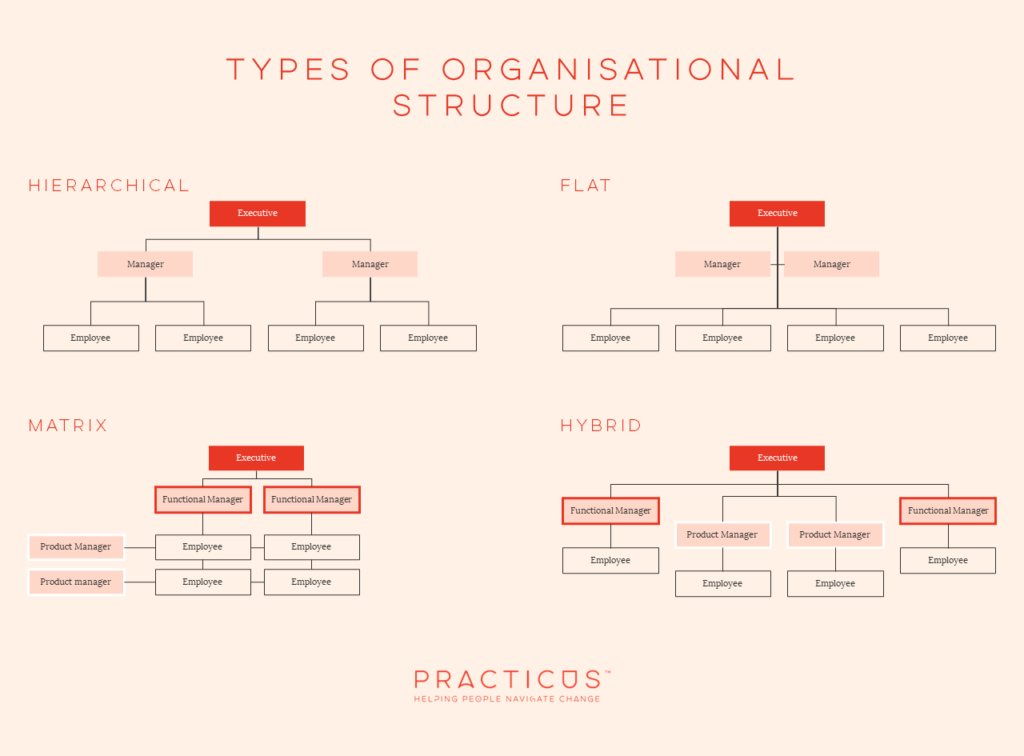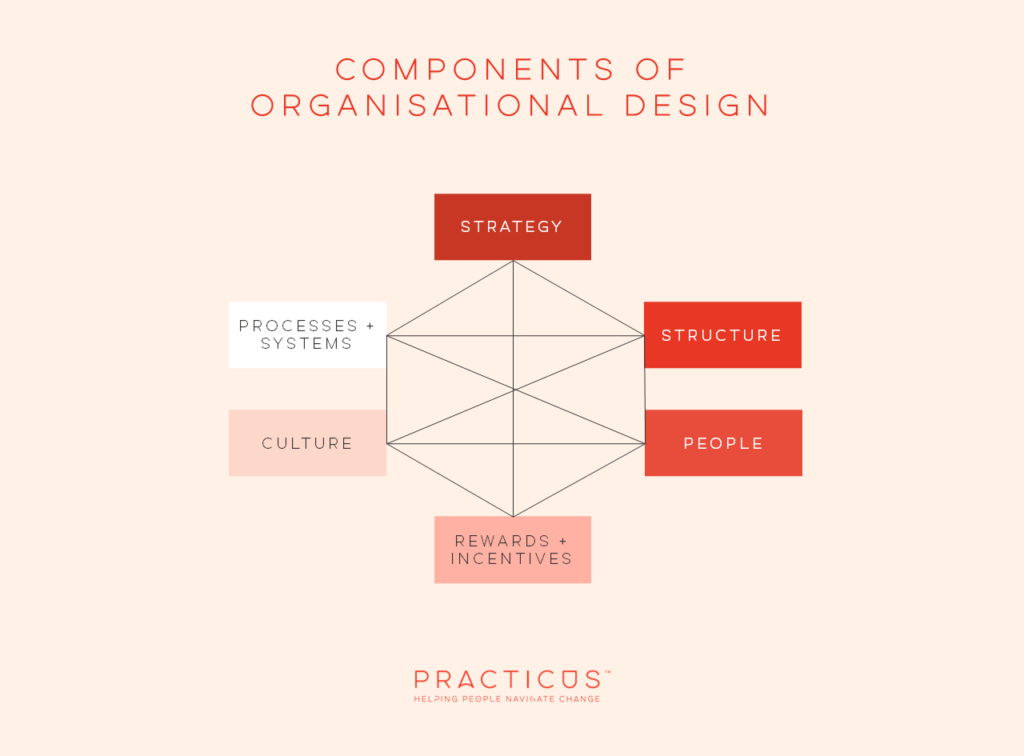
Organisational Design
Organisational design is a critical process that aligns the structure of an organisation with its mission, values, and strategic goals, thereby driving efficiency and productivity. This involves creating roles, defining reporting lines, and establishing effective communication and decision-making processes.
Jon Webster
Imagine setting sail on turbulent seas with no compass, chart or North Star to guide your journey. Daunting, isn’t it? That’s precisely what running an organisation without a well-thought-out organisational design can feel like. A solid organisational design, also referred to as org design, is what drives everyone in your business in the same direction amidst the stormy seas of business, guiding your enterprise towards its strategic objectives while fostering efficiency and productivity.
As a business with a significant track record in HR consultancy for organisations large and small, we can share a thing or two about organisational design best practice.
So, lash your mainsail as we embark on this fascinating voyage through the deep waters of organisational design. We’ll navigate through the principles that serve as guiding stars, uncover the secrets of designing organisations holistically and discover the critical role of leadership in charting the course. Get ready to explore a world where strategy, structure and culture align to create a resilient, adaptable, and high-performing organisation. Hold on tight, this ride promises to be exciting, enlightening and instrumental to your organisation’s success!

In the evolving world of business, organisational design has become a crucial aspect of ensuring efficiency and productivity. This guide offers an insight into the importance of organisational design and key principles to consider when designing organisations.
Understanding Organisational Design
Understanding organisational design is paramount for leaders aiming to build effective, resilient businesses. This understanding can aid in creating an environment that not only facilitates productivity and innovation but also nurtures employee satisfaction and retention. After all, a well-designed organisation is a thriving organisation.
What is organisational design in simple terms?
At its core, organisational design is the process of aligning the structure of an organisation with its mission, values, and strategic goals. This involves creating roles, defining reporting lines, and establishing processes to drive effective communication and decision-making. The objective is to create an environment that facilitates the accomplishment of the organisation’s strategic objectives.
Organisational design’s concept is rooted in the systematic arrangement of components within a workplace to achieve those goals. The result is streamlined operations that ensure a productive, efficient and harmonious working environment.
As unique as your organisation
It’s crucial to realise that effective organisational design is not a one-size-fits-all solution. It needs to be tailored to your unique organisation. Consequently, just because a competitor is doing things one-way and seems to be having success does not mean that is how your should be doing it.
This is one of the reasons to limit or at least be careful with benchmarking in the organisation design process. It’s a common myth that best practice is transferrable. Often success is the result of many factors and a product of the overall system – people, process and technology – all working in unison. This is at the core of organisational design philosophy.
Not a “One and done”
While you may be undergoing a big shift through organisation design, it’s important to remember that the work is never quite final. There is no ultimate form to an organisation and it will need continual evolution. This further work may not be as grand in scale but will be every bit as important to organisational effectiveness.
In short, organisational design is an ongoing process that requires continual adaptation to your unique needs, environment and strategic goals. The design should be flexible enough to respond to the ever-changing market conditions and industry trends, while being robust enough to maintain stability and operational efficiency.
Structure is just one consideration
The practical implementation of organisational design involves defining clear roles and responsibilities, setting a distinct chain of command and coordinating diverse aspects of the organisation. In short, structure is just one component and often not the most important. Often, implementation can be achieved using various structures, such as hierarchical, flat, matrix or hybrid structures. (There are many others.) Each of these structures carries its own benefits and drawbacks, so it’s essential to select the one that best aligns with the organisation’s culture, size, and goals.
Here are a few examples:

It may seem counter-intuitive but structure should be the last thing you change. The other aspects need to be considered first and really all elements should be considered as a whole to work in unison.
Organisation Design: The Fundamentals
Organisation design goes beyond creating an organisational chart. It involves shaping the organisation in a way that allows it to adapt to changing circumstances. This includes aligning organisational structure with strategy, fostering a culture that supports the organisation’s vision, and setting up operational processes that drive efficiency.
Of course, organisational design can be broken down into several key components. It’s important to note that these components are interconnected, and changes in one can significantly impact the others.
Remember, good organisational design aligns these components to work together towards achieving the strategic goals of the organisation. When these components are in sync, the organisation can operate more efficiently, adapt to changes faster, and foster a more productive and satisfying work environment.
Here are the fundamental components:
Strategy
The business strategy lays the foundation for organisational design. It defines the organisation’s goals and objectives, and guides the structure and systems that need to be put in place to achieve them. Strategy includes defining the mission, vision, and strategic initiatives of the organisation, as well as the HR strategy.
Structure
The organisational structure is the blueprint of the company, showcasing the hierarchy and reporting relationships. It includes the formal reporting lines, the division of responsibilities, and the grouping of functions or departments (functional, divisional, matrix, etc.).
Processes and systems
These are the formal and informal procedures that drive business operations, including communication processes, decision-making processes, information systems, and performance management systems.
People
An organisation’s design must consider its people – their skills, attitudes, and behaviours. This involves defining roles and responsibilities, creating a talent strategy, and aligning the organisational culture with its people.
Culture
This involves the shared values, beliefs, norms, and customs within an organisation. A strong culture often guides employee behaviour and impacts performance.
Rewards and incentives
This system encourages certain behaviours and aligns the interests of the organisation with those of its employees. It includes compensation, recognition, and benefits that motivate and retain employees.

Designing Organisations: A Holistic Approach
Organisational design works best as a holistic approach. One that views the organisation as an integrated, interdependent system rather than a collection of individual parts. This includes the strategy, structure, culture, processes, people, and incentives – and considers how they interact and influence each other.
This interconnectedness means that a change in one aspect of the design can impact the others and that needs to be taken into consideration at the same time.
For example, introducing a new process might require altering the structure, which in turn could affect the roles and responsibilities of the people involved. And that in turn may change culture.
Furthermore, the holistic nature of organisational design extends beyond the organisation’s internal environment to include the external context as well. Market trends, industry forces, regulatory environments and societal changes can all influence the optimal design of an organisation.
Worth it
Yes, it is hard but making changes without regard for unintended consequences will ultimately prove tougher in the long run. If you’ve ever made well meaning changes in the past – or witnessed a colleague do it – only to produce a bigger mess than you started with, you’ll understand why it is important.
In fact, the best way to look at it is that holistic organisational design is your safeguard against exactly these kinds of scenarios. It’s worth doing for this reason alone. And it ultimately enhances the organisation’s ability to achieve its goals effectively and efficiently.
Organisation Design Principles
While each organisation might have unique needs, certain universal organisation design principles can guide the design process.
What are the 5 principles of organizational design?
- Alignment with Strategy: The design of the organisation should align with its strategy. This ensures that the organisation’s structure and processes support its strategic objectives.
- Simplicity: The organisational design should be as simple as possible, reducing complexity and fostering clear understanding of roles and responsibilities.
- Flexibility: The design should allow the organisation to adapt to changes in the business environment.
- Balance: There should be a balance between centralisation and decentralisation, depending on the organisation’s needs and strategic goals.
- Empowerment: The design should empower employees, promoting engagement and productivity.
Organisational design principles: key to success
Implementing the above organisational design principles effectively can contribute significantly to an organisation’s success. It can enhance decision-making, streamline operations, promote innovation, and improve customer service.
Successful implementation of organisational design principles often hinges on a comprehensive understanding of the organisation’s strategic goals and the environment in which it operates.
Implementing organisational design principles successfully involves aligning the design with the strategy, ensuring flexibility, and providing strong leadership and clear communication. When these principles are applied effectively, they can significantly enhance the performance and competitiveness of the organisation.
Applying the principles
Here’s a deeper look into how to successfully apply these principles:
Firstly, it’s crucial to align the organisational design with the company’s strategy. This means that the structure, processes, and systems, along with the people and the culture, should all support the strategic objectives of the organisation. For instance, if the strategy involves fostering innovation, the organisational design might include flatter structures to promote collaboration, decision-making processes that encourage risk-taking, and a culture that values creativity and learning.
In addition, flexibility is key. In today’s rapidly changing business environment, organisational designs should be agile enough to adapt to new market trends, technology advances, and evolving customer needs. This might involve implementing cross-functional teams to respond quickly to new opportunities or challenges, or adopting new technologies to enhance productivity and efficiency.
Finally, successful implementation of organisational design principles requires strong leadership and effective communication. Leaders must not only model the behaviours and values reflected in the new design but also communicate the rationale behind the design changes clearly and consistently. This helps to reduce resistance to change and encourages buy-in from all members of the organisation.
Org Design: A Continual Process
Org design isn’t a one-time event, but a continuous process. As the business environment changes, the organisational design needs to be reassessed and adjusted accordingly to ensure it remains effective.
This is due to the dynamic nature of the business environment. Companies operate in markets that are constantly evolving due to technological advancements, changing customer needs and preferences, regulatory changes, competitive pressures, and various other factors. To stay competitive, organisations need to be agile and adaptable, continuously reviewing and adjusting their design to respond effectively to these changes.
Examples
For instance, consider the rise of digital technology and e-commerce. Traditional brick-and-mortar retail companies had to reassess their organisational design to integrate online channels effectively. This might have involved creating new roles or departments focused on digital marketing and online sales, implementing new IT systems, and altering processes to ensure smooth coordination between online and offline operations.
Similarly, the recent global pandemic necessitated many organisations to adopt remote working arrangements. This significant shift required changes in organisational design to support effective communication, maintain employee engagement, and manage performance in a virtual setting. It led to the implementation of new digital tools, modifications in managerial roles and responsibilities, and adjustments to HR policies and practices.
Another example could be a company that has decided to pursue international expansion. To do so successfully, it may need to adapt its organisational design to account for cultural differences, regulatory requirements, and market conditions in the new geographical locations. This could involve creating regional offices with local teams, implementing new coordination mechanisms, and adjusting its product development processes.
These examples highlight why organisational design can’t be a one-off activity but rather a continual process. It’s about maintaining a fit between the organisation’s design and its environment to ensure that it can effectively achieve its objectives amidst changing conditions.
Organisation Design - The Role of Leadership
Leaders play a crucial role in organisation design. They must be proactive in driving the design process, communicating the vision, and fostering a culture that supports the organisation’s strategic objectives.
To break that down, leaders not only create the vision and strategic direction that guides the design of the organisation but they are also responsible for executing and maintaining this design. Their decisions and actions directly influence the structure, systems, culture, and overall functioning of the organisation.
For example, in setting the strategic direction, a leader might identify the need for the company to become more innovative to maintain competitiveness. This decision would influence the organisational design by encouraging a structure that promotes collaboration and cross-pollination of ideas, like a flatter or matrix structure. The leader might also advocate for open communication, flexibility, and risk-taking, helping to cultivate a culture of innovation.
Moreover, leaders are pivotal in managing change associated with shifts in organisational design. They need to clearly communicate the rationale behind the changes and how these changes align with the organisation’s strategic goals. By doing so, they can help reduce resistance and foster buy-in among employees. For instance, when Satya Nadella took over as CEO of Microsoft, he initiated a cultural shift towards a “growth mindset”. This change in the organisational culture was communicated effectively and led to increased collaboration and innovation.
Lastly, leaders play a significant role in aligning the reward and incentive systems with the desired behaviours and outcomes based on the organisation’s design. For instance, if the organisational design is focused on team-based projects, leaders might implement a rewards system that recognises team performance, thereby promoting cooperation and shared accountability.
Organizational Design: An International Perspective
Considering any international challenges is particularly important when discussing organisational design, especially for multinational companies (MNCs) or organisations looking to expand overseas. When operating across different countries and cultures, a ‘one size fits all’ approach to organisational design is once again to be avoided.
An international perspective on organisational design involves understanding and integrating various cultural, legal, and market differences into the design process. It also requires managing the complex trade-offs between global integration and local responsiveness, and between coordination and flexibility. This approach can help MNCs operate effectively and successfully in the diverse and dynamic international business environment.
Here are some factors to consider from an international perspective:
Diverse cultural contexts
Different countries have distinct cultural norms, values, and practices, which can significantly influence the effective design of an organisation. For instance, hierarchical structures may work well in cultures with high power distance (like China or Japan), but not as well in cultures that value egalitarianism (like Denmark or Sweden). Understanding and integrating these cultural differences into the organisational design is crucial for success.
Regulatory and legal systems
Different countries have different legal and regulatory systems. These can influence several aspects of organisational design, including the division and delegation of responsibilities, reporting structures, and HR practices.
Economic and market conditions
Economic conditions and market maturity can also vary significantly across countries, impacting strategic decisions and thus organisational design. For example, the design of operations in emerging markets might focus more on flexibility and adaptability due to high market volatility.
Global-local dilemma
MNCs often face the challenge of balancing global integration and local responsiveness, sometimes referred to as the global-local dilemma. Organisational design plays a critical role in managing this balance. For example, a global product division structure can facilitate worldwide coordination and control, while a geographical division structure can cater to local market needs effectively.
Coordination and control
In international organisational design, coordinating activities and maintaining control across borders is a significant challenge. Therefore, design should consider the mechanisms for cross-border coordination and control, such as the use of global teams, standardisation of processes, or the establishment of regional headquarters.
FAQ
Answers to popular organisational design questions.
What are the 4 types of organisational design?
The four types of organizational design structure commonly referred to are “Functional”, basing it on jobs; “multi-divisional”, basing it on divisions; “Flat”, keeping the levels of management low; or “Matrix”, using a mix of job and product reporting lines. Other ways to set up a company are using circles, teams or network structures.
What are the six elements of Organisational design?
The six elements of Organisational Design are Departmentalisation, the chain of command, the span of control, centralisation or decentralisation, work specialisation and the degree of formalisation. (Bobbins, Judge, & Campbell, 2012)
What are the three 3 common organizational designs?
The three 3 common organizational designs are are Hierarchical, Sequential and Matrix.
What are the 3 modern organizational design theories?
The three 3 modern organizational designs are the systems approach, the socio-technical approach and the situational approach.
The “systems approach” considers the organization as a system made up of a inter-related, mutually-dependent sub-systems.
The “socio-technical approach” views the organization as a social system with associated technical system and wider environment.
The“situational approach” treats organizational systems as integrated with their environment and that differences in the environment mean different organizational relationships are needed for the organisation to be effective.
What are the 3 key guidelines to develop organizational structure?
The 3 key guidelines to develop organizational structure are “Governance” (who will make decisions), “Rules” (by which the organization operates) and “Distribution of work” (how the work will be divided up).
What is Organisational design model?
An organizational design model is a tool the organization uses to: understand its current state, visualize a future desired state and define the identity—purpose, value, and culture— that will enable it to flourish.
Further reading
Numerous experts have significantly contributed to the understanding of organisational design. Below are a few authors who are widely recognized as authorities in this field:
Henry Mintzberg: Mintzberg is an acclaimed academic and author known for his work on business and management structure. His book, “The Structuring of Organizations,” offers in-depth insights on organisational structure and design.
Jay R. Galbraith: Galbraith was a renowned expert on organisation design. His ‘Star Model’ is a fundamental framework in the field. He wrote several books on the topic, including “Designing Complex Organizations” and “Designing Organizations: Strategy, Structure, and Process at the Business Unit and Enterprise Levels.”
Amy Kates & Gregory Kesler: Kates and Kesler are known for their practical approach to organisational design. They co-authored the book “Designing Your Organization: Using the STAR Model to Solve 5 Critical Design Challenges,” which is widely used by both academics and practitioners.
Robert Duncan: Known for his work on organisational environments and strategy, Duncan’s work has also had a significant influence on organisational design theory. His research on how companies can effectively manage and adapt to their external environments provides a crucial element to organisational design.
Michael Porter: While Porter is most famous for his work on competitive strategy, his insights have significant implications for organisational design. The alignment of organisational structure and strategy is a key aspect of effective design, an area in which Porter’s work offers valuable guidance.
John P. Kotter: Kotter is a leading authority on leadership and change. His work on leading change is particularly relevant to organisational design, given that changes in design often require significant organisational change management.
Christopher Alexander: An architect by training, Alexander’s work on pattern languages has been influential in various fields, including organisational design. His ideas about recurring problem/solution pairs offer a novel perspective on designing effective organisations.
Get Support for organisational design
Make contact today. All discussions in confidence.

Natalie Allen
Client Engagement Partner






